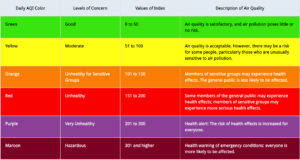After years of improvement, rising traffic and climate change could produce a return of ozone alerts.
By Johannes Werner
Original Air Date: May 31, 2024
Host: If you were coughing while walking the beach in the last few days, it was not because of Red Tide. Sarasota County on Thursday issued an advisory for high levels of ozone at Lido Beach. According to local measurements by the county, the Air Quality Index was 105 on a scale of 250. The U.S. Environmental Protection Agency’s color scale ranges from yellow to deep purple, and the 105 put us in the orange level. Our news team has the details.
Johannes Werner: Tampa was also on ozone alert on Thursday. As of Friday, the level was back down to a moderate yellow in Sarasota, probably in part thanks to a sprinkle of rain here and there. But there now was an alert in St. Petersburg, as unusually hot and dry weather continues to affect the entire Tampa Bay area. Level orange means people with respiratory disease and active children and adults should reduce what the EPA calls “prolonged outdoor exertion”.
What’s causing elevated ozone levels? Vehicle and power plant emissions of nitrous oxides turn into ozone when excessive heat and sun are present. So unless rainy season finally begins, expect ozone to remain an issue here.
But the outlook isn’t good: According to long-term forecasts, June will remain hot and dry, with only scattered thunderstorms. Rain is expected to be clearly below average.

Graphic showing the color codes of ozone levels
The ozone alert is happening as ozone smog has actually declined over the past two decades or so. Thanks to cars becoming cleaner, gas stations with fewer fume leaks, and cleaner fuels, the number of alert days per year in the Tampa Bay area has dropped considerably.
Katherine Pruitt is the nationwide director of Clean Air Policy for the American Lung Association.
Katherine Pruitt: I see a pattern that we see in many places in the Southeast, which is one of pretty steady improvements since we first started doing the report in the year 2000. A report that was published in 2002 — you know, so that was over 20 years ago — the Tampa area had an average number of high ozone days that was almost 40 bad ozone days a year. And that number has been coming down over time, because of the changes that we’ve seen, that have been made because of the requirements of the Clean Air Act. So one of the things that we’ve seen over that time is that sources of pollution have been getting cleaned up. Cars are cleaner. Fuel is cleaner. Smokestacks are cleaner, and that’s all paid off very nicely in reducing the number of ozone days, especially in the Southeast and the Mid Atlantic.
JW: But that trend may be reversing now, due to climate change and the growing number of people and vehicles in this area.
KP: There are more autos on the road. Although those cars are cleaner than they were 25 years ago, more of them is still going to make a lot of pollution, but once those pollutants come out of the tailpipes of the autos and out of the gas pumps at the filling station, it goes up into the atmosphere. And if the weather is hot and sunny, that cooks. Those pollutants cook together in the presence of sunlight to create ground level ozone pollution. And the hotter it gets, the faster those reactions happen.
So you’re right that climate change, drought, a lot of sunny days, and more heat is likely to worsen ozone problems. And it definitely is bad for particle pollution, if you’re in an area that’s susceptible to wildfires.
JW: In its latest “State of the Air” report, based on data from 2020 through 2022, the American Lung Association gave the Tampa Bay metro area the dubious distinction of the third-worst in the Southeast for ozone pollution. Our area was the 71st most polluted in the nation.
The ranking was based on the average number of unhealthy days in the area’s worst county. That was Hillsborough County, with 1.3 days per year from 2020 through 2022, a “C” grade. This was actually better than the area’s ranking in last year’s report of 49th worst, with 2.7 ozone alert days per year. That was a “D” grade.
But we may be falling back again now. So what can be done?
KP: Make sure that cars are getting cleaner. We’re really looking for ways to reduce our reliance on fossil fuels because that’s really a key to both ozone and particle pollution. So continuing our efforts to clean up power plants, including natural gas fire power plants, continuing to clean up cars, reducing our reliance on the use of fossil fuels and going towards zero emission technologies is really going to be critical to both slow down the pace of climate change and help control air pollution.
JW: Reporting for WSLR News, this has been Johannes Werner.
WSLR News aims to keep the local community informed with our 1/2 hour local news show, quarterly newspaper and social media feeds. The local news broadcast airs on Wednesdays and Fridays at 6pm.